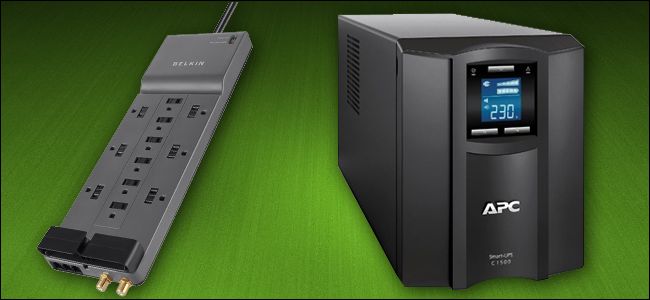
Most PC users understand that a power surge, blackout, or other sudden loss of electricity has the capacity to seriously hurt your computer. But exactly what one should do to protect against it gets a little fuzzier. The two most common means of protection are a standard surge protector, sometimes (wrongly) called a power strip, or an uninterruptible power supply, usually shortened to UPS. (No connection with the delivery guys in the brown shorts.)
Which one is right for your computer setup? That depends on exactly what you’re doing, and how much protection you want.
|
Surge Protectors: Simple Protection For Electronics
Some people refer to a surge protector as a power strip, because they look more or less identical. This is a dangerous conflation: while a simple power strip might include a cheap circuit breaker (or not), it’s essentially just an extension of your wall power outlet, allowing more electronics to be plugged in at once but offering no significant extra protection. A consumer-grade surge protector has multiple outlets as well, but it also includes a shorting mechanism and a ground line that will physically block excess electrical energy from reaching your devices.
Surge protectors range from simple to complex, with pricier versions packing in ten or more electrical outlets, plus extra in and out lines for other types of electronic equipment like phone lines, Ethernet cords, USB power, and coaxial cables. All that stuff is nice, and could certainly come in handy if you’re planning an elaborate desk or television setup.
But in terms of pure protection, what you’re looking for is the joule rating. Surge protectors offer an amount of electrical joules for which they are rated to stop, and the higher the better.Power surges can be light—like your home’s internal grid re-adjusting when someone plugs in a hair dryer or a vacuum cleaner—or heavy, like when your satellite dish takes a direct lightning strike. Generally joule ratings range from under 1000 joules for the cheaper models to over 3000 for more elaborate versions. Since the more expensive models in this case aren’t actually all that expensive, getting maximum protection for your stuff doesn’t require a huge investment.
Most surge protectors include a small LED light that indicates the safety ground is still working. Some more elaborate versions have a tiny LCD screen for the same purpose. Be sure to periodically check that the light is still on, especially after thunderstorms or power outages.
UPS: For Saving…
The post Surge Protectors vs. UPS: Do You Really Need a Battery Backup for Your PC? appeared first on FeedBox.